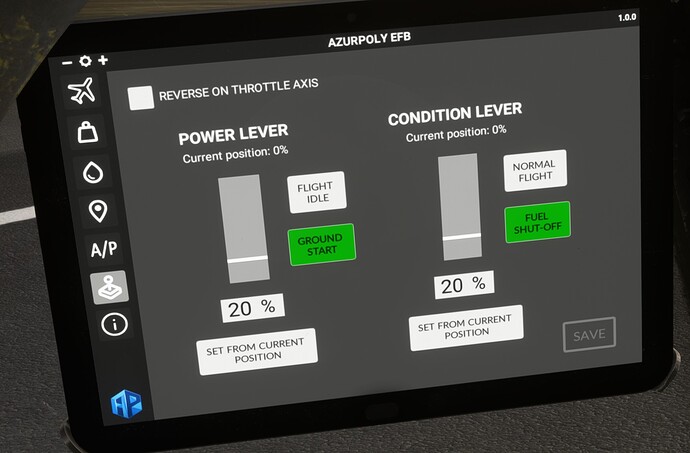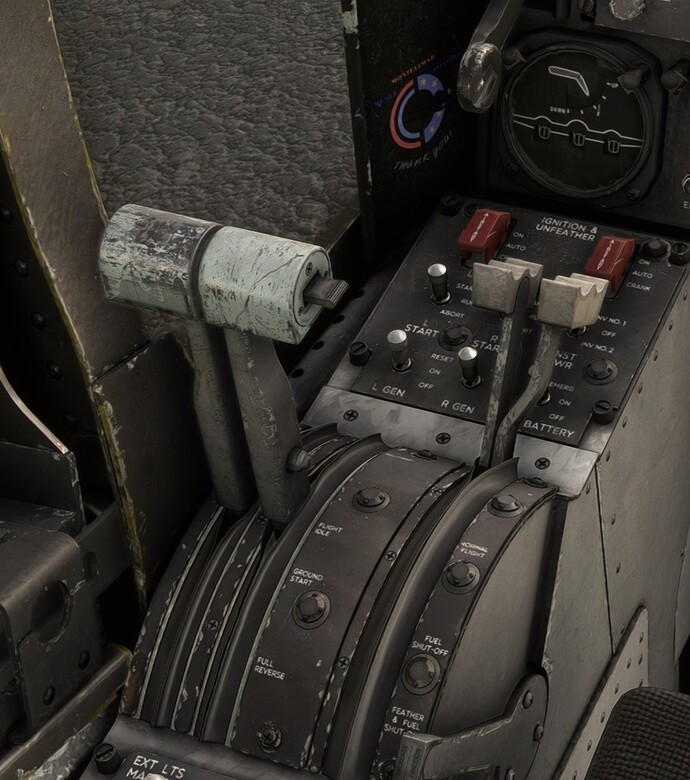I see that the PMS50 GTN650 is an available option in this plane. The paid version of the PMS50 (and maybe the TDS?) has a built-in autopilot. Anyone know if this autopilot works in this plane, vice having to use the tablet autopilot? This might sway my purchase decision.
I have the PMS50 and will try it on my next flight.
I have about 15 hours on her and probably used the ap only a couple of times.
It is not really an IFR type of bird imo.
Low and fast, canyon running, sightseeing with a fantastic view (especially in VR) is where she excels.
Its great fun.
Someone dared me to shoot an NDB approach with a teardrop turn, and I was pleasantly surprised that it all worked well, even hand-flown. That said, your head needs to be angled way down to do your scan, which isn’t fun. The transition to visual is a bit unnerving.
I’ll second that. This airplane is VR Wow.
Way faster off the ground than I expected too. Almost helicopter like take off.
I noticed that too, except for low, side-to-side peripherals. In VR I have good visual sense on the sides when down in the instruments. There are a number of instruments to monitor. But the flying itself is pure VFR. Put some modern avionics in and it’s dead simple.
It’s kind of an attack version of a C152 crossed with an A-10. Like is it between 1945 or 1985?
For me the PMS50 GTN650 auto pilot works fine. tbh, I haven’t used it (yet) to follow complex flight plans, but at least for basic functionality I can approve it works. The disadvantage of the GPS device, it is placed in the window area, so it slightly degrees the overall visibility (which may be, oth, an advantage as the GPS is easily visible most of the time.)
Awesome, thanks for the confirmation. Going to get this soon! I’ll probalby stick to visual and VOR navigation, but nice to have the non-tablet based AP (and GPS as an option).
This would be my first combat sim plane purchase*, after a couple of thousand hours amongst everything from single engine props to the big tubeliners. My 90-year-old Dad is a long-retired Air Force Col., so I’ll have to ask him if he has any flight line stories about this model.
*Unless you count Chuck Yeager’s Air Combat and F-119 Stealth Fighter when I was a youngster.
I did a first flight yesterday and I really like it overall. Not too fond of the way the throttles operate, though. They never really line up properly with my physical reverse thrust detent, even when using the EFB throttle tool. It’s not a problem on any other aircraft, so why here?
I hope the throttle logic will see an overhaul soon.
EDIT: tried another flight and the throttle is a total mess. When I physically pull the throttle all the way back past the reverse detent it is in Flight Idle only (and I have to pull it all the way back to even get it in flight ide) but once I land the reverse range becomes availabe and kicks in with full power, because the hardware throttle is indeed in the full reverse position. Makes no sense, and I can’t get it sorted with the EFB.
Alright, I dove in and bought this plane and am tinkering with it right now.
What I think it’s doing by design is allowing the throttle to have full range (full reverse to full thrust) while on the ground, but only flight idle to full thrust when in the air (weight on wheels sensor)?
Throttles with detents are always kind of a pain as a simmer, unless you have a physical throttle (i.e. TM Airbus quadrant) that has actual detents. I’ve got the Boeing TM quads, and sort of have things working.
I’m sure we’ll have more detailed YouTube videos showing throttle/condition lever setups as more people start flying this.
At the moment this is how it is intented to work. Different Axis Ranges during flight and on the ground.
The Devs (AzurPoly) are reading this thread and responded to this already multiple times.
Maybe they consider adding an optioen to disable this and have same axis ranges during flight and on ground.
Cheers
Yeah, but it’s a terrible system. To bleed off speed to land I have to go all the way to idle. The throttle then snapping to full reverse as soon as I touch down is a messy affair. It caused me veering off the runway when I tried landing with one engine out, because I got immediate asymmetrical reverse thrust as soon as I touched down.
Why does it even work like that? It’s awful.
I dont like it much either.
But I am sure they had good intentions behind this and AzurPoly seem to react very reasonable to critcism like this.
Let´s see what the first patch brings.
A new update to the TDS GTN750XI/650 allows for use of the above two systems in the OV10. The 650 can be used in the virtual cockpit sitting on top of the coaming. I dont have the aircraft (but am very tempted) as I am holding out for the Duke pair, but am just passing this on from the TDS Discord page. Hope it helps some of you.
IMO , it is the most usefull and effective implementation of reverse thrust, similar to the DC-6.
I use a Thrustmaster Viper TQS so I don’t have a reverse axis on the throttle - only a proxy button action when I pass through a detent.
Using the button keybind to switch to reverse/beta (Togggle Throttle Reverse Trust), I can switch the axis and alternate the function to beta range/reverse axis. I then have full control of the reverse power level as if it was a regular axis (albeit in the forward axis motion and not pulling backwards on the throttle. It works flawlessly for me, and the keybind works reliably for me, unlike in the DC-6.
It’s not exactly hardcore realistic as the real life cockpit throttle, but it allows for full and precise throttle control over both the normal and reverse throtttle range available.
The only challenge I had was that the instructions we’re not clear about the implementation, and it took me an hour or two before I realized and decide on the best choice of throttle setting for me - but as you mention, it was one of the first things they responded too and are already going to address.
I agree with you for people with no Detent or Reverse Axis. But if you have Hardware with an reverser Axis and Detent this implementation feels a little bit odd.
But either way, the Rest of the Quality Addon makes up for this in my opinion. If they change it - it would just be the cherry on top of the other cherries.
Cheers
Not trying to be “that guy” just wondering what kind of approach you’re flying.
To borrow a concept from the airlines is to fly a stabilized approach. In the OV-10 it would be something like being configured with gear and 20 flaps at 100 KIAS [edit: at ~1500’ AGL] about 5 NM out from the runway. With ~50% fuel those parameters require ~40% power (according to the HUD display).
My HOTAS doesn’t have throttle detents so I haven’t programmed anything into the EFB.
So I only get Flight Idle at touchdown and the airplane still slows pretty quickly (no my parking brake isn’t on either).
My point is that perhaps you might consider for the time being undoing the EFB Power Lever program. ![]()
I’m loving this airplane, it made me subscribe to Navigraph just so I could get the moving map (with forward up orientation on my iPad). I use the FAA Sectional charts and program low level flights on VR and IR routes that I flew in a previous life (and routes new to me in the NW). Now have to get a new RAM mount for my iPad.
Like it a lot! except the ailerons, they feel massively overpowered to the point of destabilising the a/c ( and somewhat crazily effective even just above stall too ). While I appreciate it’s got stubby little wings ( but also has outboard engines ), it feels more like I’m twisting the entire wing. Wierdly half the time it feels like it has some weight in roll & half the time it doesn’t, it’ll think a bit about starting to roll like any aircraft, but it can sometimes roll instantly, and then sometimes just stop rolling instantly too, it’s rather disconcerting ( it’s the same in pitch too occasionally, and can you really pull the real one into a stall in a turn without using all the stick travel? ). It’s possible to have controls that need a light touch without them being that effective, so I’m sure some tuning could be done. Doesn’t feel particularily fluid right now, unfortunately.
Dunno why anyone’s complaiing about reverse, you have so much pitch authority you can aero brake it almost to a standstill ![]()
@VanDisaster That’s a thing with the real Bronco. It’s extremely fast in roll, but also has a very pronounced yaw effect during big aileron inputs.
A very good demonstration of that effect can be seen here:
I think AzurPoly did a fantastic job simulating this idiosyncrasy of the Bronco.
Well it does with any AoA on, later on in that display it’s pretty ok. I don’t mind needing coordinated inputs to roll properly - the first time I rolled it I put some rudder in halfway because I could see the nose drifting off - but this at times feels like it’s gone a bit beyond that & into flow separation areas, especially if you’re a tad ham-fisted. From eyeballing that vid the model looks like it does need some more effective inertia in roll ( it is extremely agile but even just from that vid there is noticeable angular acceleration, not like a RC plane’s instant snaps and the snap response you get 50% of the time in our model ) - if you do some wing waggling like the final pass of the vid in our a/c you’ll get way more instant response, for example. Doesn’t have to come from adding inertia, it can come from reducing damping & then reducing control surface force ( I notice this has a lot of msfs stability settings added, I hate that ![]() those settings seem to choke aircraft feel )
those settings seem to choke aircraft feel )
I agree though they did do a nice job! I think it just needs a little bit more tuning. I’m not complaining for the sake of it, I just think they nearly got it but it could flow better. Or to put it another way I want one that is just like that vid, and I’m pretty ■■■■ sure we can get there without much effort.
I do like how we’ve finally got a turboprop that actually slows you down at flight idle!


